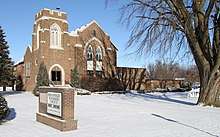Hollandale, Minnesota
Hollandale is a city on State Highway 251 in Freeborn County, Minnesota, United States. The population was 303 at the 2010 census.[6]
Hollandale | |
|---|---|
 | |
 Location of Hollandale, Minnesota | |
| Coordinates: 43°45′36″N 93°12′11″W | |
| Country | United States |
| State | Minnesota |
| County | Freeborn |
| Area | |
| • Total | 0.44 sq mi (1.14 km2) |
| • Land | 0.44 sq mi (1.14 km2) |
| • Water | 0.00 sq mi (0.00 km2) |
| Elevation | 1,207 ft (368 m) |
| Population | |
| • Total | 303 |
| • Estimate (2019)[3] | 299 |
| • Density | 679.55/sq mi (262.12/km2) |
| Time zone | UTC-6 (Central (CST)) |
| • Summer (DST) | UTC-5 (CDT) |
| ZIP code | 56045 |
| Area code(s) | 507 |
| FIPS code | 27-29636[4] |
| GNIS feature ID | 0645087[5] |
Geography
According to the United States Census Bureau, the city has a total area of 0.44 square miles (1.14 km2), all of it land.[7]
Demographics
| Historical population | |||
|---|---|---|---|
| Census | Pop. | %± | |
| 1940 | 219 | — | |
| 1950 | 360 | 64.4% | |
| 1960 | 363 | 0.8% | |
| 1970 | 287 | −20.9% | |
| 1980 | 290 | 1.0% | |
| 1990 | 289 | −0.3% | |
| 2000 | 292 | 1.0% | |
| 2010 | 303 | 3.8% | |
| Est. 2019 | 299 | [3] | −1.3% |
| U.S. Decennial Census[8] | |||
2010 census
As of the census[2] of 2010, there were 303 people, 128 households, and 81 families living in the city. The population density was 688.6 inhabitants per square mile (265.9/km2). There were 146 housing units at an average density of 331.8 per square mile (128.1/km2). The racial makeup of the city was 96.4% White, 2.6% from other races, and 1.0% from two or more races. Hispanic or Latino of any race were 9.6% of the population.
There were 128 households, of which 31.3% had children under the age of 18 living with them, 46.9% were married couples living together, 7.8% had a female householder with no husband present, 8.6% had a male householder with no wife present, and 36.7% were non-families. 30.5% of all households were made up of individuals, and 17.9% had someone living alone who was 65 years of age or older. The average household size was 2.37 and the average family size was 2.91.
The median age in the city was 38.8 years. 26.7% of residents were under the age of 18; 9.4% were between the ages of 18 and 24; 21.5% were from 25 to 44; 25.4% were from 45 to 64; and 17.2% were 65 years of age or older. The gender makeup of the city was 53.1% male and 46.9% female.
2000 census

As of the census[4] of 2000, there were 292 people, 131 households, and 88 families living in the city. The population density was 677.0 people per square mile (262.2/km2). There were 137 housing units at an average density of 317.6 per square mile (123.0/km2). The racial makeup of the city was 95.55% White, 4.45% from other races. Hispanic or Latino of any race were 8.22% of the population.
There were 131 households, out of which 25.2% had children under the age of 18 living with them, 55.0% were married couples living together, 6.1% had a female householder with no husband present, and 32.8% were non-families. 32.1% of all households were made up of individuals, and 16.0% had someone living alone who was 65 years of age or older. The average household size was 2.23 and the average family size was 2.73.
In the city, the population was spread out, with 22.9% under the age of 18, 5.8% from 18 to 24, 25.3% from 25 to 44, 19.5% from 45 to 64, and 26.4% who were 65 years of age or older. The median age was 42 years. For every 100 females, there were 86.0 males. For every 100 females age 18 and over, there were 89.1 males.
The median income for a household in the city was $26,250, and the median income for a family was $41,875. Males had a median income of $33,214 versus $20,313 for females. The per capita income for the city was $15,972. About 11.8% of families and 15.2% of the population were below the poverty line, including 28.9% of those under the age of eighteen and 4.7% of those 65 or over.
Notable people
References
- "2019 U.S. Gazetteer Files". United States Census Bureau. Retrieved July 26, 2020.
- "U.S. Census website". United States Census Bureau. Retrieved 2012-11-13.
- "Population and Housing Unit Estimates". United States Census Bureau. May 24, 2020. Retrieved May 27, 2020.
- "U.S. Census website". United States Census Bureau. Retrieved 2008-01-31.
- "US Board on Geographic Names". United States Geological Survey. 2007-10-25. Retrieved 2008-01-31.
- "2010 Census Redistricting Data (Public Law 94-171) Summary File". American FactFinder. United States Census Bureau. Retrieved 27 April 2011.
- "US Gazetteer files 2010". United States Census Bureau. Archived from the original on 2012-01-25. Retrieved 2012-11-13.
- "Census of Population and Housing". Census.gov. Retrieved June 4, 2015.
